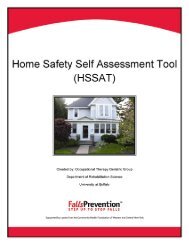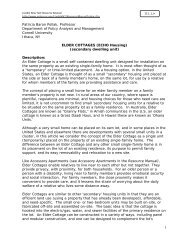Sustaining Informal Caregivers - New York State Office for the Aging
Sustaining Informal Caregivers - New York State Office for the Aging
Sustaining Informal Caregivers - New York State Office for the Aging
You also want an ePaper? Increase the reach of your titles
YUMPU automatically turns print PDFs into web optimized ePapers that Google loves.
study is likely due to differences between this survey of caregivers of older adults, contrasted to<br />
most national surveys of caregivers, which include caregivers of various ages and care receivers<br />
of all levels of disability. <strong>Caregivers</strong> in this study are exclusively caregivers of older adults, and<br />
most of <strong>the</strong> care receivers have serious health problems and significant functional limitations,<br />
leading to a need <strong>for</strong> more supportive care.<br />
Overall, <strong>the</strong> amount of caregiving hours that caregivers provided ranged from less than 10 to as<br />
much as around-<strong>the</strong>-clock care, or care provided 24 hours a day, 7 days a week. The survey<br />
findings show that:<br />
• 17 percent of caregivers provided less than 10 hours a week of care;<br />
• 33 percent provided 10 to 39 hours of care;<br />
• 15 percent provided 40 to 79 hours of care;<br />
• 6 percent provided 80 to 99 hours of care; and<br />
• 29 percent provided more than 100 hours of care – close to around-<strong>the</strong>-clock care to<br />
<strong>the</strong>ir loved ones.<br />
Of those caregivers reporting that <strong>the</strong>ir care receivers have Alzheimer’s disease or o<strong>the</strong>r<br />
dementia, 46 percent reported that <strong>the</strong>ir care receivers cannot be left alone and that <strong>the</strong>y provided<br />
an average of 10.3 hours of care per day. That amount of care equates to more than a full-time<br />
job.<br />
<strong>Caregivers</strong> who live with <strong>the</strong>ir care receivers also reported that <strong>the</strong>y provide considerably more<br />
care than caregivers who do not live with <strong>the</strong>ir care receivers. For instance, caregivers reported<br />
that <strong>the</strong>y provided an average 90.4 hours per week of help to <strong>the</strong>ir care receivers, as compared to<br />
10








